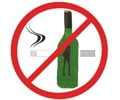
"We've shown a much greater risk for coinfected compared to uninfected persons at all levels of alcohol consumption—from nonhazardous drinking up to hazardous/binge drinking and abuse/dependence," said senior author Vincent Lo Re III, MD, MSCE, assistant professor of Medicine and Epidemiology in the division of Infectious Diseases and department of Biostatistics and Epidemiology at Penn and an infectious disease physician at the Veteran Affairs Medical Center in Philadelphia. "This highlights how important it is for clinicians to be counseling co-infected patients on reducing alcohol consumption. More communication and education about the risks of alcohol may prompt patients to reduce drinking or quit altogether, which will help reduce the incidence of complications."
Few studies have investigated the association between alcohol and liver disease in HIV/HCV-co-infected patients, and none have compared risks to uninfected persons.
For the study, researchers, which included first author Joseph K. Lim, MD, of the Yale University School of Medicine and the Veterans Affairs Connecticut Healthcare System, conducted a cross-sectional study among 7,270 participants from the Veterans Aging Cohort Study: 701 HIV/HCV co-infected; 1,410 HIV-mono-infected; 296 HCV-mono-infected; and 1,158 uninfected. Alcohol use was determined by the Alcohol Use Disorders Identification Test-Consumption (AUDIT-C) questionnaire and diagnoses of alcohol abuse/dependence and classified as nonhazardous drinking, hazardous/binge drinking, and alcohol-related diagnosis.
The team found that regardless of HIV or HCV status, the prevalence of advanced hepatic fibrosis increased as alcohol use category increased. However, the strongest associations were observed in co-infected patients across all alcohol categories compared with uninfected non-hazardous drinkers.
Co-infected individuals with nonhazardous drinking were 13 times more likely to have advanced liver fibrosis than uninfected persons who reported non-hazardous drinking. Co-infected patients with a history of hazardous/binge drinking were 17 times more likely, whereas those who had alcohol-related diagnosis were 21 times more likely, to have advanced liver fibrosis compared to their uninfected non-hazardous drinking counterparts.
Advertisement
Advertisement













